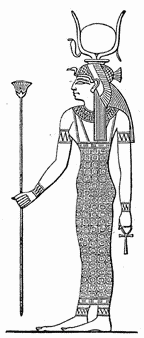Pharaonic dance
The so-called Pharaonic Dance is a fantasy dance . The Pharaonic dances are usually titled after the depicted Egyptian rulers ( dance of Cleopatra ) or gods ( dance of Hathor ).
The pharaonic fantasy dance has no direct historical sources. The model for the pharaonic dances and costumes are the Egyptian wall paintings from tombs in Egypt . Many dancers refer to well-known pharaohs like Akhenaten , Nefertiti , Cleopatra VII , Hatshepsut or Egyptian goddesses like Isis , Hathor , Maat or Neith .
The music played for the dance can be freely selected according to the expression of the dance and is usually sedate, dramatic and slow. The movements and choreographies of the dancers are based on the posture and gestures of the people depicted on the tomb paintings of pharaonic Egypt. Typical Egyptian costumes and jewelry, as well as the crown of the pharaohs, and necklaces ( Egyptian collar ) are used here. The symbols of the Egyptian rulers, as well as the symbols of the Egyptian gods (e.g. the ankh sign), are used as accessories in dance. In representations (dances) of the goddess Isis , the extensive golden and pleated veil (often with sticks as an extension) or wing veil is striking. The wing veil should represent the wings of the goddess.
Usually various different arm poses and postures are taken at a slower and more relaxed pace. Researchers and dancers such as Laurel Victoria Gray are convinced that the effective dances in ancient Egypt were sometimes quite acrobatic and were not performed slowly and sedately.
literature
- Wendy Buonaventura: Serpent of the Nile: Women and Dance in the Arab World , Interlink Publishing Group, 1998, ISBN 1-5665-6300-3
- Karin Van Nieuwkerk: A Trade Like Any Other: Female Singers and Dancers in Egypt , University of Texas Press, 1995, ISBN 0-29278-723-5
- Wendy Buonaventura: Belly dance , Kunstmann Verlag, 1998, ISBN 3-8889-7106-3
- Dietlinde Bedauia Karkutli: The Belly Dance Book , Rowohlt 2002, ISBN 3-4996-1328-X
- Eluan Ghazal: The sacred dance. Oriental dance and sacred eroticism , Simon & Leutner, 2005, ISBN 3-92238-995-3
- Eluan Ghazal: snake cult and temple love. Sacred eroticism in archaic societies , Simon + Leutner, 1995, ISBN 3-92238-963-5
